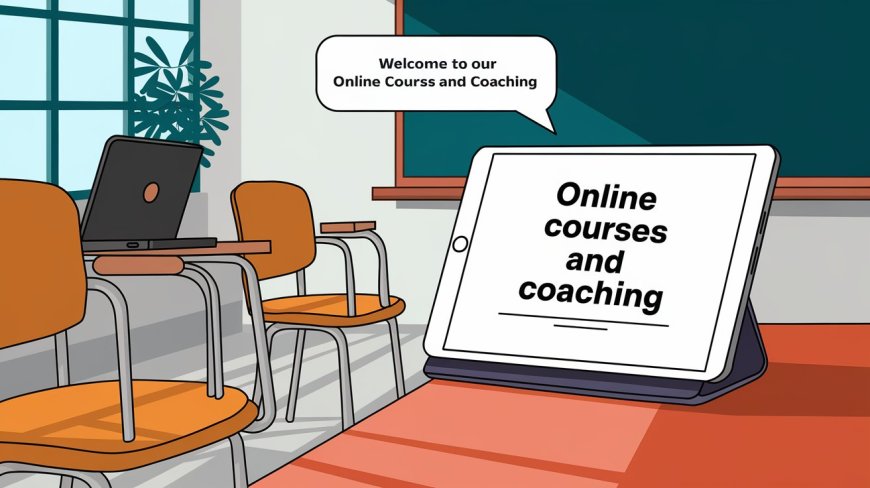Online Courses and Coaching: Transform Your Expertise into Income
Online Courses and Coaching Why Teach Online? The growing demand for online education and personal coaching. Identifying Your Expertise: How to choose a subject or skill you can teach. Creating an Online Course: Step-by-step guide to planning, recording, and launching a course. Platforms for Hosting Courses: How to choose between platforms like Udemy, Teachable, and Skillshare. Pricing Your Course: Tips on setting the right price for your course based on value and market demand. Marketing and Selling Your Course: Strategies for promoting your course through social media, email marketing, and partnerships. Offering Coaching Services: How to provide one-on-one coaching sessions and scale your business.




Why Teach Online? The Growing Demand for Online Education and Personal Coaching
In recent years, online education and personal coaching have seen an exponential rise in demand. This surge can be attributed to several factors: the increasing accessibility of the internet, the flexibility that online learning offers, and the desire for continuous learning in a rapidly evolving world. People are turning to online platforms to acquire new skills, advance their careers, or pursue personal interests at their own pace and from the comfort of their homes.
The COVID-19 pandemic further accelerated this trend, as traditional education and training systems were disrupted, leading both educators and learners to embrace digital solutions. As a result, online courses and coaching have become not only a viable alternative to in-person learning but a preferred choice for many. This shift presents a significant opportunity for anyone with expertise in a particular field to share their knowledge, help others achieve their goals, and earn a substantial income in the process.
Whether you are a seasoned professional, a skilled hobbyist, or someone with a unique life experience, there is likely an audience willing to pay for your insights and guidance. By teaching online, you can reach a global audience, create a passive income stream, and build a brand around your expertise.
Identifying Your Expertise: How to Choose a Subject or Skill You Can Teach
Before you start teaching online, it’s essential to identify the subject or skill you can teach. Your expertise doesn’t necessarily have to be academic; it could be anything that others find valuable, from cooking and fitness to graphic design and personal development. Here’s how to identify your teaching niche:
-
Assess Your Skills and Knowledge: Start by listing out your skills, knowledge areas, and experiences. What are you passionate about? What do people often ask for your help with? Consider both your professional background and personal interests.
-
Research Market Demand: Once you’ve identified potential topics, research the demand for each. Use platforms like Google Trends, YouTube, and online course marketplaces to see what topics are popular. Look for areas where demand is high, but competition isn’t too saturated.
-
Define Your Target Audience: Understand who your ideal students are. What are their pain points, goals, and learning preferences? By defining your audience, you can tailor your content to meet their needs effectively.
-
Validate Your Idea: Before investing time and resources in creating a course, validate your idea. You can do this by conducting surveys, pre-selling your course, or offering free webinars to gauge interest. If people are willing to pay or show strong interest, you’ve likely found a viable topic.
-
Consider Your Unique Selling Proposition (USP): Think about what sets you apart from others teaching the same subject. Your USP could be your teaching style, your approach to the topic, or your unique perspective. Emphasize this uniqueness in your course description and marketing materials.
Creating an Online Course: Step-by-Step Guide to Planning, Recording, and Launching a Course
Creating an online course involves careful planning, content creation, and effective marketing. Here’s a step-by-step guide to help you launch a successful course:
-
Plan Your Course: Start by outlining your course objectives and the learning outcomes you want your students to achieve. Break down the content into modules or sections, and create a detailed course outline. This plan will serve as a roadmap for your course creation process.
-
Create Course Content: Once your outline is ready, start creating the course content. This can include video lessons, downloadable resources (like PDFs, worksheets, and templates), quizzes, and assignments. When recording videos, ensure good lighting and sound quality, as these are crucial for a professional presentation.
-
Choose the Right Equipment: You don’t need expensive equipment to create a course, but investing in a good microphone and camera can significantly improve the quality of your videos. Use screen recording software if you’re teaching something that requires a computer demonstration.
-
Record and Edit Videos: Record your videos in a quiet space with minimal distractions. Speak clearly and confidently, and use visual aids to enhance understanding. After recording, edit your videos to remove any mistakes, add captions, and include transitions or animations where necessary.
-
Design Your Course Materials: Design the downloadable resources that accompany your course. These materials should reinforce the content and provide additional value to your students. Tools like Canva can help you create professional-looking resources.
-
Upload Content to a Platform: Once your content is ready, upload it to an online course platform. Platforms like Udemy, Teachable, and Skillshare make it easy to organize your content into a structured course. You can also host your course on your own website using tools like WordPress and LearnDash.
-
Set Up Assessments and Interactivity: Engage your students by incorporating quizzes, assignments, and interactive elements into your course. This not only reinforces learning but also makes the course more engaging.
-
Launch Your Course: Before launching, create a marketing plan to promote your course. Set a launch date and build anticipation through social media, email campaigns, and partnerships. Consider offering an early-bird discount or bonuses to incentivize initial sales.
-
Gather Feedback and Improve: After launching, gather feedback from your students to identify areas for improvement. Use this feedback to refine your course content, improve the learning experience, and update your materials as needed.
Platforms for Hosting Courses: How to Choose Between Platforms Like Udemy, Teachable, and Skillshare
Choosing the right platform to host your course is crucial, as it will impact your reach, control over your content, and profitability. Here’s a comparison of popular platforms:
-
Udemy: Udemy is one of the largest online course marketplaces, offering access to millions of students worldwide. It’s an excellent platform if you’re looking to reach a broad audience quickly. However, Udemy sets strict pricing guidelines, and they take a significant portion of your revenue. It’s best for beginners who want to validate their course idea without upfront costs.
-
Teachable: Teachable is a platform that allows you to create, market, and sell your courses from your own website. It offers more control over your content, pricing, and branding. Teachable is ideal for those who want to build a brand and have more flexibility in course creation. However, it requires more marketing effort on your part, as you’ll be responsible for driving traffic to your courses.
-
Skillshare: Skillshare operates on a subscription model, where students pay a monthly fee for access to all courses on the platform. Instructors earn royalties based on the number of minutes their courses are watched. Skillshare is great for reaching a creative and professional audience, and it’s easier to get started. However, the revenue potential may be lower compared to platforms like Teachable.
-
Kajabi: Kajabi is a premium platform designed for entrepreneurs who want to create and sell not only courses but also memberships, coaching programs, and digital products. It offers extensive marketing tools, including email campaigns, landing pages, and webinars. Kajabi is suitable for those looking to build a comprehensive online business, but it comes with a higher cost.
-
Thinkific: Thinkific is similar to Teachable, offering a user-friendly platform to create and sell courses from your own website. It provides robust customization options and is ideal for those who want to have complete control over their brand. Thinkific also offers a free plan with limited features, making it accessible for beginners.
Pricing Your Course: Tips on Setting the Right Price for Your Course Based on Value and Market Demand
Setting the right price for your course can be challenging, as it needs to reflect both the value you provide and what the market is willing to pay. Here are some tips for pricing your course:
-
Understand Your Audience: Research your target audience’s willingness to pay. If your audience consists of professionals looking to advance their careers, they may be willing to pay more than hobbyists.
-
Analyze Competitors: Look at how similar courses are priced. Consider the length, content depth, and instructor reputation when comparing. If your course offers more value or a unique approach, you can justify a higher price.
-
Consider Your Expertise: If you’re an expert in your field with years of experience, your course should be priced accordingly. People are willing to pay more for courses taught by recognized authorities.
-
Factor in Course Length and Depth: Longer courses with more in-depth content typically justify a higher price. However, make sure the content remains valuable and engaging throughout.
-
Use Tiered Pricing: Consider offering different pricing tiers based on the level of access or additional resources. For example, you could offer a basic version of the course at a lower price and a premium version with additional coaching sessions or resources at a higher price.
-
Offer Discounts Strategically: Use discounts during the launch or special promotions to attract students. However, avoid frequent discounts that could devalue your course.
-
Test and Adjust: You can always test different price points to see what resonates with your audience. Start with an introductory price and adjust based on feedback and sales performance.
Marketing and Selling Your Course: Strategies for Promoting Your Course through Social Media, Email Marketing, and Partnerships
Marketing your course effectively is crucial to its success. Here are some strategies to help you sell more courses:
-
Build an Email List: Start building an email list before launching your course. Offer a free resource, like an eBook or webinar, to attract subscribers. Email marketing is one of the most effective ways to promote your course and nurture leads.
-
Leverage Social Media: Use social media platforms like Facebook, Instagram, LinkedIn, and Twitter to promote your course. Share valuable content related to your course topic, engage with your audience, and use paid ads to reach a larger audience.
-
Create a Sales Funnel: Develop a sales funnel that guides potential students from awareness to enrollment. A typical sales funnel might include a free lead magnet (such as a mini-course or webinar), followed by an email sequence that educates and nurtures leads, and finally a compelling offer to purchase your course. Tools like ClickFunnels or Kajabi can help you build and automate your funnel.
-
Host Webinars: Webinars are an excellent way to showcase your expertise and provide value to your audience. During the webinar, you can offer a preview of what students can expect from your course, answer questions, and create a sense of urgency with limited-time offers or bonuses. Webinars can be live or pre-recorded and are highly effective in converting attendees into paying students.
-
Partner with Influencers: Collaborate with influencers or other educators in your niche to promote your course. They can help you reach a broader audience and lend credibility to your offer. This partnership could take the form of joint webinars, guest blogging, or affiliate marketing where they earn a commission for each sale generated through their referral.
-
Use Content Marketing: Regularly publish content related to your course topic on your blog, YouTube channel, or podcast. Content marketing helps establish your authority and keeps your audience engaged. SEO-optimized blog posts or videos can drive organic traffic to your course landing page, increasing your chances of enrollment.
-
Leverage Paid Advertising: Invest in paid advertising on platforms like Facebook, Instagram, Google Ads, or LinkedIn to reach a targeted audience. Paid ads allow you to hone in on specific demographics, interests, and behaviors that align with your ideal students. Retargeting ads can also be used to remind people who visited your course page but didn’t enroll.
-
Offer Testimonials and Case Studies: Social proof is a powerful tool in convincing potential students to purchase your course. Collect testimonials from your early students and share success stories. If you have worked with clients or students in the past, create case studies that highlight their achievements as a result of your teaching.
-
Run Affiliate Programs: Encourage others to promote your course by offering an affiliate program. Affiliates can be bloggers, influencers, or even your students who are willing to recommend your course to their network in exchange for a commission on each sale. This can significantly expand your reach without requiring upfront marketing costs.
-
Engage in Community Building: Create a community around your course through social media groups, forums, or a dedicated community platform like Circle or Slack. A strong community can enhance the learning experience, provide ongoing support, and encourage word-of-mouth referrals. Engage regularly with your community to keep them motivated and connected.
-
Track and Analyze Your Marketing Efforts: Use analytics tools to track the performance of your marketing campaigns. Monitor key metrics such as conversion rates, cost per lead, and return on investment (ROI). Based on the data, adjust your marketing strategies to improve results. Platforms like Google Analytics, Facebook Insights, and email marketing software offer valuable insights into your audience’s behavior.
-
Offer Limited-Time Bonuses: Incentivize potential students to enroll by offering limited-time bonuses, such as additional resources, one-on-one coaching sessions, or discounts. This creates a sense of urgency and encourages immediate action.
Offering Coaching Services: How to Provide One-on-One Coaching Sessions and Scale Your Business
In addition to creating and selling online courses, offering one-on-one coaching services can be a lucrative way to monetize your expertise. Coaching allows you to provide personalized guidance, support, and accountability to individuals who are looking to achieve specific goals. Here’s how to get started:
-
Define Your Coaching Niche: Just like with online courses, it’s important to define your coaching niche. This could be based on your professional experience, a personal passion, or a unique skill set. Examples include career coaching, life coaching, business coaching, fitness coaching, or mindset coaching. The more specific your niche, the easier it will be to attract clients who need your expertise.
-
Develop a Coaching Framework: Create a structured approach to your coaching sessions. Develop a framework or methodology that outlines how you will work with clients, what goals you will help them achieve, and the steps you will take to get there. Having a clear process not only adds credibility to your coaching but also ensures consistency and effectiveness in your sessions.
-
Set Your Coaching Rates: Determine your coaching rates based on your experience, the value you provide, and the market demand. You can charge per session, offer package deals, or set up a subscription model where clients pay a monthly fee for ongoing coaching. Consider offering a free discovery call to potential clients to discuss their needs and how you can help.
-
Create a Coaching Agreement: Draft a coaching agreement that outlines the terms of your coaching relationship, including the duration, frequency of sessions, payment terms, and confidentiality. This agreement sets clear expectations and protects both you and your clients.
-
Market Your Coaching Services: Promote your coaching services through your website, social media, email list, and network. Share success stories, testimonials, and case studies to demonstrate the value of your coaching. You can also offer free workshops, webinars, or challenges to attract potential clients and showcase your coaching style.
-
Use Online Tools for Coaching Sessions: Leverage online tools like Zoom, Skype, or Google Meet to conduct coaching sessions remotely. These platforms allow you to work with clients from anywhere in the world, providing flexibility and convenience for both parties. Consider using scheduling tools like Calendly to streamline the booking process.
-
Offer Group Coaching: In addition to one-on-one coaching, consider offering group coaching programs. Group coaching allows you to work with multiple clients at once, making it more scalable and cost-effective. Clients benefit from the support and insights of the group, while you can maximize your time and income.
-
Create Digital Products for Your Coaching Clients: Develop digital products, such as eBooks, workbooks, templates, or guided meditations, that complement your coaching services. These products can be sold as standalone offerings or bundled with your coaching packages, providing additional value to your clients and generating passive income.
-
Expand Your Reach with Online Communities: Build an online community for your coaching clients where they can connect, share experiences, and support each other. This community can be hosted on social media platforms, a private forum, or a dedicated app. Engaging regularly with your community helps maintain client motivation and fosters a sense of belonging.
-
Scale Your Coaching Business: As your coaching practice grows, consider scaling your business by hiring additional coaches, offering certification programs, or licensing your coaching framework to other professionals. You can also create an online course or membership site based on your coaching methods, allowing you to reach a broader audience and generate passive income.
By combining online courses with coaching services, you can create a comprehensive educational business that meets the diverse needs of your audience. Whether they prefer self-paced learning or personalized guidance, you’ll have the tools to help them succeed while building a sustainable and profitable online business.

